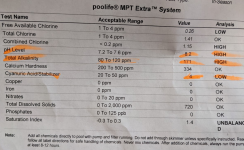Deb04
LifeTime Supporter
- Jul 12, 2008
- 779
- Pool Size
- 19000
- Surface
- Vinyl
- Chlorine
- Salt Water Generator
- SWG Type
- Pentair Intellichlor IC-40
CalHypo is fine IF your Calcium is not too high. With a Vinyl pool it can't be too low, unless you have a heater. Even with a heater it doesn't need to be very high.
Do you have an Ocean State Job Lot near you? Their liquid chlorine is $4.99/gallon and is 12.5% and super fresh. I bought some last week and it was bottled 6/14/22. Their 65% CalHypo is 4.99/ lb. A gallon of 12.5% liquid chlorine raises FC in my pool 6.6. A pound of 65% CalHypo raises it 4.1. So, with that source, liquid is more economical.
I use CalHypo in the spring and fall when it's too cold for our SWG. There's almost no calcium in our well water and over the winter with snow melt there's significant water dilution. Calcium is usually around 100 when we open and 200 when we close. I use the CalHypo because its more convenient and I can buy a bunch in fall and it's still good in the Spring.
You'll be able to test your Calcium when your test kit arrives and see if it's too high. Best to use liquid chlorine until then just in case. If it turns out your Calcium is low, you can go back to CalHypo and test calcium periodically to keep an eye on it.
Do you have an Ocean State Job Lot near you? Their liquid chlorine is $4.99/gallon and is 12.5% and super fresh. I bought some last week and it was bottled 6/14/22. Their 65% CalHypo is 4.99/ lb. A gallon of 12.5% liquid chlorine raises FC in my pool 6.6. A pound of 65% CalHypo raises it 4.1. So, with that source, liquid is more economical.
I use CalHypo in the spring and fall when it's too cold for our SWG. There's almost no calcium in our well water and over the winter with snow melt there's significant water dilution. Calcium is usually around 100 when we open and 200 when we close. I use the CalHypo because its more convenient and I can buy a bunch in fall and it's still good in the Spring.
You'll be able to test your Calcium when your test kit arrives and see if it's too high. Best to use liquid chlorine until then just in case. If it turns out your Calcium is low, you can go back to CalHypo and test calcium periodically to keep an eye on it.



